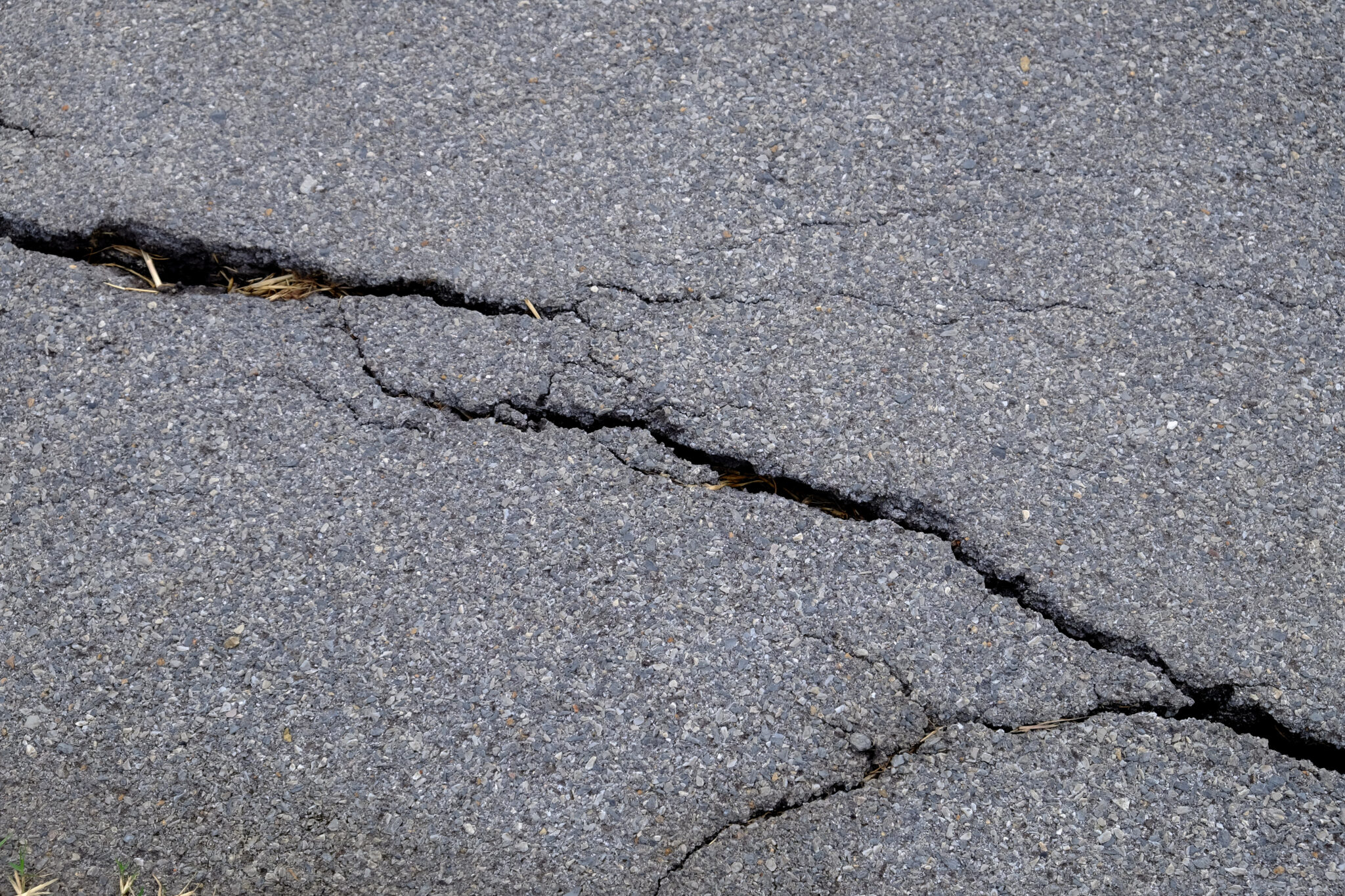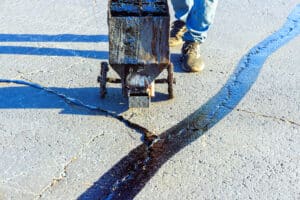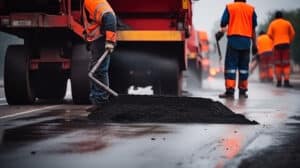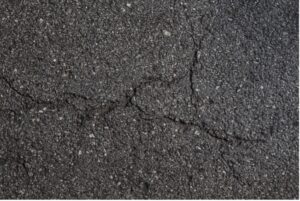Have you ever been on a road trip and felt the car start rumbling as it hits a bumpy patch of road? These bumps are not just ordinary cracks but transverse cracks, which can be a nightmare for property owners. Transverse are perpendicular to the direction of traffic, forming a series of ‘humps’ or ridges across the surface of the road. These cracks are an indication of underlying issues and, if not addressed, can lead to more extensive and costly repairs. Below, we will explore the causes, consequences, and possible cures for transverse cracking on asphalt surfaces.
Identifying Transverse Cracking
Before getting into the causes of transverse cracking, it’s important to know how to identify this type of pavement damage. One of the easiest ways to spot transverse cracking is by looking at the crack pattern on the asphalt surface. Unlike longitudinal cracks, which run parallel to the direction of traffic, transverse cracks form a series of perpendicular cracks across the road. This can lead to the road looking like a series of connected ridges.
In addition to their distinct pattern, transverse cracks are wider than other types of cracks and can span the entire pavement width. This makes them more noticeable and potentially more dangerous for drivers. If you see these cracks on your property, act quickly so they don’t worsen and cause more damage.
Causes of Transverse Cracking on Asphalt
Transverse cracking can start to form for a variety of reasons, but they all have one common factor: stress on the pavement. Some possible causes of transverse cracking include:
Thermal Expansion and Contraction
One of the primary causes of transverse cracking is the thermal expansion and contraction of the asphalt. As temperatures change, the pavement expands and contracts. During extreme temperature changes, this expansion and contraction can exceed the material’s tolerance, leading to cracks. In colder climates, the freeze-thaw cycle speeds up this effect as water seeps into tiny crevices, freezes, expands, and creates cracks.
Material Quality and Construction Flaws
The quality of materials used in asphalt construction and the construction process itself can influence the development of transverse cracks. Low-quality materials may not have the necessary flexibility and strength to withstand the loads and environmental conditions they are subjected to. Additionally, improper construction techniques, such as inadequate compaction of the base layers or improper mixing of asphalt, can lead to weak spots that are prone to cracking. These flaws in the construction phase turn into transverse cracks as the pavement begins to settle.
Overloading and Traffic Stresses
Heavy traffic loads can also lead to transverse cracks. Vehicles, especially heavy trucks, exert stress on asphalt surfaces. Over time, this stress can cause the pavement to crack, particularly if the pavement is not designed to handle such loads.
Reflective Cracking
Reflective cracking occurs in pavements where an asphalt layer overlays another layer of existing asphalt. This type of cracking is caused by the movement and shifting of the underlying layers, which is then “reflected” into the top layer of asphalt. The transverse cracks can allow water to penetrate the pavement structure, leading to more damage.
Each of these causes of transverse cracking highlights the importance of proper pavement design, construction, and maintenance.
Why is Transverse Cracking an Issue?
Transverse cracks may seem like a minor inconvenience, but they can quickly develop into huge headaches if left untreated. Here are some of the issues transverse cracking can cause:
Moisture Infiltrating the Pavement
Transverse cracks create pathways for water and other substances to infiltrate the asphalt structure. Once water gets through these cracks, it can weaken the base and subgrade layers, leading to structural damage and expensive repairs. This cycle of deterioration can shorten the lifespan of an asphalt pavement, leading to early failure.
Safety Hazards
Transverse cracks can be a safety hazard to road users. Large cracks can affect drivers’ ride quality and comfort and may lead to more severe pavement failures like potholes, which are direct threats to vehicle safety. Additionally, water pooling in cracks can lead to slippery conditions, especially when the water freezes in cold weather.
Reduced Aesthetic Value
Beyond structural concerns, transverse cracks are not a pretty sight on a property. Large, visible cracks can decrease the property value and may negatively impact the perception of potential customers or tenants.
It can be tempting to overlook transverse cracks as a minor issue, but the consequences of ignoring them can be significant. If you notice transverse cracking in your asphalt pavement, call a professional ASAP to inspect the surface and recommend the next steps.
Repairing Transverse Cracking on Your Property
Depending on the size of the transverse cracks, there are various repair options available. Here are some potential solutions a professional contractor may recommend:
Crack Sealing
Crack sealing involves filling the cracks with a specialized rubberized material, effectively sealing the crack and preventing water from seeping in. This is a standard solution for smaller transverse cracks that have not yet caused significant damage to the pavement. This is usually the first line of defense against transverse cracks and can help prolong the life of your pavement.
Overlay
If the transverse cracking is extensive and affects a large portion of your pavement, an overlay may be a great solution. This involves laying a new layer of asphalt over the existing pavement, effectively creating a new surface. This option is more costly but can be a long-term solution for preventing further cracking and improving the overall appearance of your pavement.
Resurfacing
If the asphalt’s sub base is damaged or unstable, resurfacing may be necessary. This involves removing the top layer of pavement and repairing any underlying issues before laying a new surface on top. Resurfacing can address transverse cracking as well as other types of damage, such as potholes or alligator cracking.
Replacement
In extreme cases where the asphalt is beyond repair, complete replacement may be necessary. This involves removing all of the existing pavement and starting from scratch with a new subbase and asphalt surface. While this is the most costly option, it may be necessary in severe cases.
Regardless of which solution is recommended for your transverse cracking issue, it’s important to address the problem as soon as possible.
How to Prevent Transverse Cracking in the First Place
If your asphalt pavement is still new or in good condition, there are steps you can take to prevent transverse cracking from plaguing your surface:
- Sealcoating: Applying a sealcoat to your asphalt surface every 2-3 years can help protect it from the damaging effects of UV rays, water, and other elements.
- Proper drainage: Make sure your pavement has proper drainage to prevent standing water, which can weaken the subbase and lead to cracking.
- Regular maintenance: Keep an eye on your pavement and address any small cracks or damage before they have a chance to spread and become bigger problems.
- Proper installation: Hiring a reputable contractor who follows industry best practices can ensure your asphalt is installed correctly and has a better chance of withstanding the elements for longer.
It’s also important to keep in mind that even with proper preventative measures, some level of wear and tear is inevitable. However, regular maintenance and preventative measures can help to decrease the chance of transverse cracking on your pavement.
Fix Transverse Cracking on Your Property with Superior Asphalt Today!
For property owners, transverse cracking is a major concern as it affects the appearance and functionality of their pavement. This type of cracking can lead to water infiltration and further damage, creating safety hazards for both pedestrians and vehicles. Don’t wait until your asphalt surfaces are riddled with transverse cracks to take action. At Superior Asphalt, we offer professional services for repairing and preventing transverse cracking on your property. Our team can assess the situation, determine the best course of action, and execute repairs efficiently and effectively. Contact us today for a quote and keep your property’s asphalt looking new.




